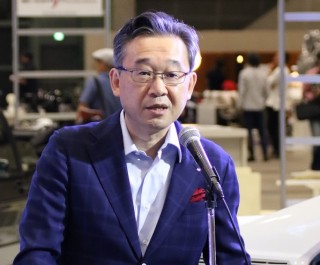Loading
Search
▼ Audi Japan President Discusses Global Shift to EVs
- Category:Event
TOKYO - Auotmaker Audi, which announced "level 3" automatic driving technology in July, is taking a lead in automatic driving, but the company is a "newcomer" to the development of EV (electric vehicle) technologies.
Toru Saito, president of a Japanese subsidiary of Audi AG, explains the status of and perspective on the development of EVs, for which competition is becoming severer.
Tell us about the status of EV development.
We are pushing forward with the development so that we will not be left behind by other companies. Specifically, we will release two kinds of EVs by 2020. We will release a large-size SUV (sport utility vehicle)-type EV in Europe in 2018 and in other countries after that.
In about 2020, we will launch a four-door coupe-type EV using the same platform. We expect to release our EVs in Japan after launching them in Europe.
How much drive range is necessary for EVs?
We will develop EVs in the aim of achieving a drive range of 500km. If an EV can run 500km, it is useful (in all scenes of our daily life).
Where is the main market for your EVs?
We will focus on releasing EVs in three countries. They are China, which is Audi's largest market, the U.S., where environmental regulations are increasingly implemented, and Europe, in which we are based. Japanese automakers including Toyota are also making a shift to EV development. The Japanese market is also an important market, and we will deal with it by releasing new vehicles.
What do you think about the global shift to EVs?
Environmental regulations are becoming stricter in the world, and the social demand for low-emission vehicles is growing. It seems that the growth is accelerating. The sense of speed is also necessary for launching EVs. The key is how much cost reduction including batteries, which are the main components, can be realized.
We are developing EV technologies, of course, but gasoline and diesel vehicles using existing engines will be our main products for the time being. We believe that the further improvement of the fuel efficiencies of existing engines is also our mission. We will push forward with the development of both new and existing technologies and increase the ratio of EVs to 30-40% in 2025.
Toru Saito, president of a Japanese subsidiary of Audi AG, explains the status of and perspective on the development of EVs, for which competition is becoming severer.
Tell us about the status of EV development.
We are pushing forward with the development so that we will not be left behind by other companies. Specifically, we will release two kinds of EVs by 2020. We will release a large-size SUV (sport utility vehicle)-type EV in Europe in 2018 and in other countries after that.
In about 2020, we will launch a four-door coupe-type EV using the same platform. We expect to release our EVs in Japan after launching them in Europe.
How much drive range is necessary for EVs?
We will develop EVs in the aim of achieving a drive range of 500km. If an EV can run 500km, it is useful (in all scenes of our daily life).
Where is the main market for your EVs?
We will focus on releasing EVs in three countries. They are China, which is Audi's largest market, the U.S., where environmental regulations are increasingly implemented, and Europe, in which we are based. Japanese automakers including Toyota are also making a shift to EV development. The Japanese market is also an important market, and we will deal with it by releasing new vehicles.
What do you think about the global shift to EVs?
Environmental regulations are becoming stricter in the world, and the social demand for low-emission vehicles is growing. It seems that the growth is accelerating. The sense of speed is also necessary for launching EVs. The key is how much cost reduction including batteries, which are the main components, can be realized.
We are developing EV technologies, of course, but gasoline and diesel vehicles using existing engines will be our main products for the time being. We believe that the further improvement of the fuel efficiencies of existing engines is also our mission. We will push forward with the development of both new and existing technologies and increase the ratio of EVs to 30-40% in 2025.
- October 14, 2017
- Comment (0)
- Trackback(0)


